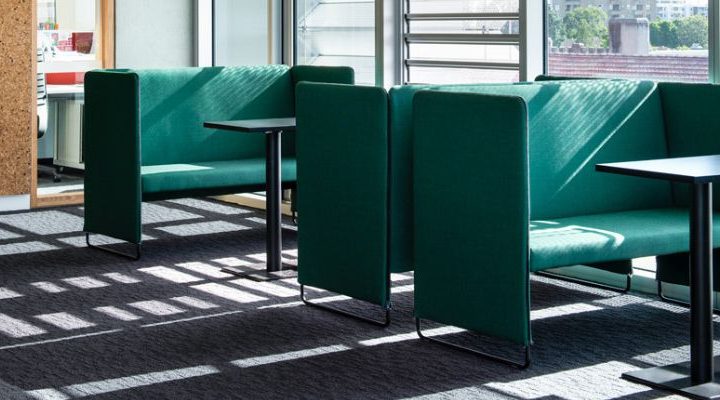
Written by Angela Ferguson in partnership with Business Interiors.
The global pandemic has highlighted the importance of relevant workplace design like never before. Prior to 2020, many leaders of organisations small and large recognised that their physical environment had the potential to play a crucial role in their business strategy, particularly when it came to performance and engagement of their staff. Now, more and more leaders are beginning to appreciate that the place in which their people work is not a fixed, static environment – and when combined with culture and technology, there is the opportunity to create the best possible workplace experience for their teams. Throughout my career as a workplace interior designer, I have found that the three key components of any successful workplace design are people, place and technology – and each should be paid equal attention to ensure a successful workplace design outcome.

This concept of People/Place/Technology all being interconnected has been a fairly consistent one in workplace design over the last 20 years. What has changed and evolved however is the manner in which each of these is addressed. Prior to the global pandemic, around 8% of Australian knowledge workers worked from home. Iin 2022 this increased to 40%. This has of course had a significant impact on the spaces in which we work. Many workplaces now are becoming much more geared towards collaboration, as this is generally reported to be the main reason people go to an office to work. Furniture plays a big role in this, with ‘owned’ desks now being shared and bookable, semi-private booths and agile furniture needed to provide visual and acoustic privacy, and flexibility and ergonomics being a key driver of new furniture specifications. In terms of ‘place’ the most effective workplaces in 2022 are implementing changes in either existing space or rethinking new space to support evolved hybrid workstyles, while providing teams with what they need to get the job done.
Just as our physical workplaces evolve, so too does people’s behaviour at work, which in turn has a ripple effect on culture. People have had to adapt to significant changes over the last couple of years, and are grappling with issues like health and wellbeing, and workplace loneliness like never before.
In my work I’ve found two schools of thought about our current rate of change. The first is that people are change fatigued and are looking for certainty, and the second is that all the changes we’ve experienced have generally made people more open to new thinking about the workplace. The key to navigating this diverse range of behaviour and workstyles is for leaders to clearly articulate the expectations of their people, and to ensure the physical environment is aligned with these expectations. So, if hybrid working means people are moving between different meeting styles throughout the day (i.e from face to face/in person to online/virtual meetings) then the workspace needs to support that by providing collaborative areas for larger groups of people, and quiet, enclosed spaces for one or two people to join a virtual call.

The workplace environment can also support an organisation’s cultural goals. For example, if better social connections between colleagues is a goal, then providing kitchen and catering spaces for people to connect with each other is one way of addressing that.
Underpinning Place and People, and enabling their effectiveness is Technology. We live in an age where technology is an inherent part of our everyday lives, and often, we don’t really miss it until its no longer there, like when the Wi-Fi doesn’t work for example. Technology is the thing that kept us connected as the world began to rapidly shut down at the beginning of the pandemic, and its importance in connecting distributed teams in a hybrid work scenario is critical. As our hybrid working patterns continue to evolve, technology is also continuing to evolve to provide better monitoring of spaces, utilisation and booking systems, as well as untether us and allow even greater mobility within our workspaces.
The way we work, post-pandemic, will never be the same. Effective workplaces of the future will have a new vision and purpose, however they will still need to consider the three important factors of People, Place and Technology. Companies like Business Interiors can support designers in their focus on the future and their ability to create workplaces that address cultural, spatial and connectivity issues, by providing furniture and settings that support these drivers.
As workplaces take on a new identity in a post-pandemic world, Business Interiors is enabling engagement, collaboration and culture with intelligent furniture solutions that address the evolving needs of employees and organisations. Contact our Business Interiors expert team to enhance your workplace – we can help with everything from a small refresh to a complete fit-out.





